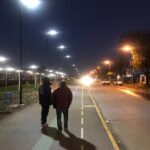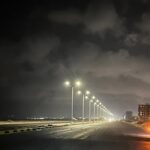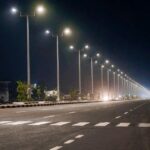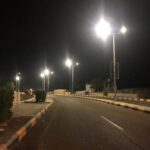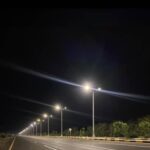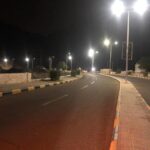In the realm of modern urban planning and sustainable development, the integration of solar street light led systems has emerged as a groundbreaking solution. These systems offer efficient and environmentally friendly lighting solutions for streets, pathways, and public spaces. When embarking on the journey of setting up such a system, several pivotal factors warrant careful consideration. Let’s dive in and discover some of these crucial factors and why they matter.

Factors To Consider When Setting up a Solar street light led system
What are the crucial factors to keep in mind?
1. Location and Sunlight Exposure
Location determines the geographical positioning of the solar street light led system. Placing them strategically in areas with maximum sunlight exposure is essential. This ensures that the solar panels receive ample sunlight throughout the day, allowing them to convert solar energy into electricity efficiently. When selecting a location, it’s important to consider potential obstructions such as buildings, trees, or other structures that could cast shadows on the solar panels and reduce their overall efficiency. A clear, unobstructed area is ideal for optimal sunlight absorption.
The sunlight exposure duration is vital for the performance of the solar street light led system. Solar panels require direct sunlight to generate sufficient power. The duration and intensity of sunlight exposure directly impact how much energy can be stored in the system’s batteries. In regions with limited sunlight hours, the solar street light system might require larger solar panels and more efficient energy storage solutions to ensure it operates effectively even during periods of reduced sunlight.
2. Solar Panel Capacity
When setting up a solar street light led system, the solar panel capacity directly influences how much energy can be harvested from the sun and stored for nighttime operation. A higher solar panel capacity means that more energy can be generated and stored, allowing the LED street lights to operate for longer durations and potentially during periods of limited sunlight.
To determine the appropriate solar panel capacity for your solar street light led system, several factors must be considered. These include the geographical location of the installation, the average daily sunlight hours, seasonal variations in sunlight availability, and the energy consumption of the LED lights themselves.
3. Battery Capacity and Type
The battery capacity refers to the amount of energy a battery can store and provide for the LED lights during periods of low sunlight or at night. Selecting the appropriate battery capacity is essential to ensure the lights can operate consistently throughout the night, even during cloudy days. Insufficient battery capacity may result in inadequate lighting during extended nights or unfavorable weather conditions. Conversely, an oversized battery can lead to unnecessary expenses and larger storage requirements.
The battery type chosen for the solar street light led system can significantly influence its overall performance and lifespan. There are several battery types commonly used in solar applications, including: lead-acid, lithium-ion, lithium iron phosphate, and nickel cadmium. Choosing the right battery type involves evaluating factors such as cycle life, capacity retention, temperature tolerance, and initial cost. Lithium-ion and LiFePO4 batteries are often favored for solar street light systems due to their reliability, longer lifespan, and reduced maintenance requirements.
4. Lighting Requirements
Illumination intensity stands as a primary consideration in this regard. Defining the appropriate level of illumination needed for the specific application becomes paramount. Variables such as the width of the road, pedestrian movement, and the surrounding environment exert influence over the requisite light intensity. Achieving proper illumination significantly enhances visibility and safety for both vehicular and pedestrian traffic.
The adaptability of the system over time is a factor to be emphasized. As traffic patterns evolve or surrounding infrastructure develops, the lighting requirements may change. An adaptable system can accommodate such changes without requiring extensive modifications, allowing for flexibility in meeting evolving needs.
5. Pole Design and Height
The selection of an appropriate pole design is crucial for ensuring the stability and durability of the solar street light led system. The pole should be designed to withstand various environmental conditions such as wind, rain, and temperature fluctuations. A sturdy pole design helps prevent potential damage to the system and ensures a longer lifespan.
The height of the pole greatly influences the distribution of light and the coverage area of the solar street light led system. A taller pole can illuminate a larger surface area, making it suitable for wide streets or open spaces. Conversely, shorter poles are ideal for narrower roads or pathways. Selecting the right pole height is essential to achieve uniform illumination and maximize the effectiveness of the lighting system.
6. Smart Lighting Controls
One key advantage of incorporating smart lighting controls is their ability to adjust illumination levels based on real-time conditions. These controls can automatically dim or brighten the lights in response to ambient light levels, ensuring that the street lights provide adequate visibility without wasting energy during daylight hours or when the area is already well-lit. This dynamic adjustment not only conserves power but also extends the lifespan of the LED fixtures, reducing the need for frequent replacements.
Smart controls also enable the implementation of motion sensors. These sensors detect movement in the vicinity of the street lights and activate them only when needed. This feature is particularly valuable in areas with fluctuating pedestrian or vehicular traffic, as it ensures that the lights are on when required, enhancing safety while avoiding unnecessary energy consumption during periods of low activity.
7. Climate and Weather Conditions
The amount of sunlight the location receives is a critical factor. Areas with consistent and ample sunlight throughout the year are ideal for solar street lights. The system’s effectiveness heavily relies on the solar panels’ ability to capture and convert solar energy into electricity. In regions with frequent cloud cover or extended periods of rain, the system’s performance might be compromised.
Extreme temperatures, whether hot or cold, can impact the performance and lifespan of the solar components. High temperatures can reduce battery efficiency and overall system performance, while freezing temperatures might affect battery capacity and solar panel efficiency. Proper insulation and temperature regulation mechanisms are essential to mitigate these effects.
8. Maintenance Accessibility
By ensuring proper maintenance accessibility, you ensure that the solar street light led system remains operational and effective over its lifespan. This involves strategically placing the components in a way that allows technicians to access them without significant obstacles. When maintenance personnel can easily reach the solar panels, batteries, LED lights, and control systems, they can quickly address any issues that arise.
Proper planning for maintenance accessibility involves selecting suitable mounting heights, designing efficient wiring and cabling systems, and incorporating features such as hinged panels or quick-release mechanisms that simplify component access. Integrating these elements into the initial design phase of the solar street light led system streamlines future maintenance efforts.
9. Wiring and electrical components
Proper wiring is essential to connect the solar panels in series or parallel configurations, depending on the desired voltage and current. The wiring should be of adequate gauge to minimize power loss and ensure efficient energy transfer from the panels to the battery and other components.
Connecting the battery also requires appropriate wiring and connections to prevent voltage drops and overheating. Ensuring the correct polarity and using high-quality connectors is crucial to maintain efficient charging and discharging cycles.
A well-grounded system prevents electrical shock hazards and reduces the risk of equipment damage. Grounding rods or plates should be securely installed and connected to the system’s components using appropriate grounding wires.
Conclusion
Establishing a solar street light led system requires careful consideration of various factors. Each factor plays a crucial role in ensuring optimal performance, longevity, and sustainability of the system. Therefore, a comprehensive assessment and strategic planning are imperative to create a well-functioning solar street light led system. Do you need a solar street light? Contact us.





